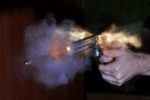OUTLINE
1.General concepts.
2.History.
3.Origen of Firearms.
4.Ballistics terminology.
5.Classification of signs of a shot.
6.Ratings (helmets, caps, bullets).
7.Gunpowder (types and use).
8.Cartridges (observation and nomenclature).
9.Projectiles (forms, speed, distance, angle). Several forms of deformations at impact.
10.Methodology for the comparison between firearms and caps.
11.Definition and observation of the interior, exterior ballistics and effects.
12.Phenomenology in the e樂威壯
ffects they produce bullets.
13.Location, lifting, packaging and research value of firearms, shells and cartridges in place of the investigation.
14.Establish whether the firearm was recently activated.
15.Federal Law on Firearms.
16.樂威壯
Legal framework of a ballistics expert.
17.Methodology of expert opinion.
18.Practice of the opinion of forensic ballistics.
OBJECTIVE
After going through this course, the student will be able to practice as an expert in forensic ballistics. He will be able to give his professional opinion before any court of justice or working in any law enforcement agency he/she can lead the investigation to the right direction.
